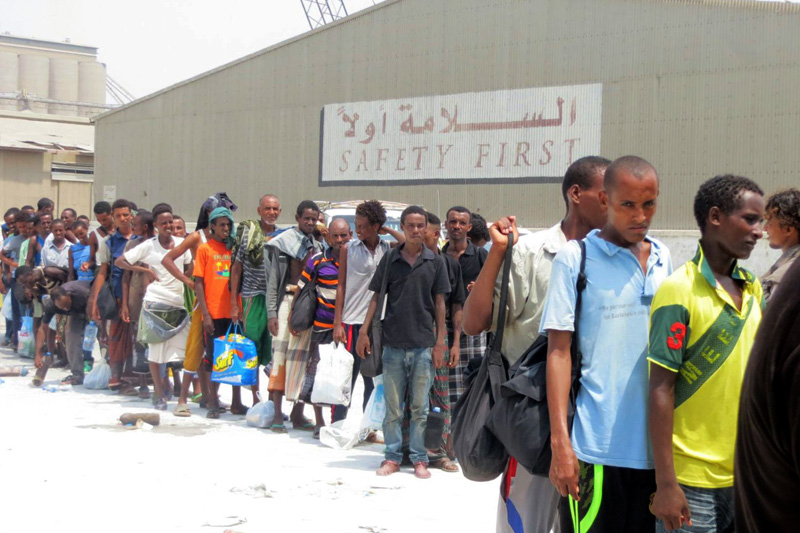Yemen has been facing ongoing violence, famine, and other disastrous elements of a four year war, and now the country is starting to see a migrant crisis brewing. Yemen has become a popular route for African migrants looking for work in the Gulf States or fleeing persecution, with some even staying in Yemen despite the ongoing conflict. Yemen’s porous borders appear to be ideal for easy access to countries like Saudi Arabia, but the reality is a horrific journey. The number of migrants attempting to travel into Yemen has grown exponentially – the United Nations (UN) International Organization for Migration (IOM) estimates that the 2018 migrant numbers will grow significantly compared to the 150,000 migrants in 2017. For these migrants, the promise of work in the Gulf States, combined with the lack of knowledge of the situation in Yemen, outweighs the risk of the dangerous journey through Yemen.
The trek often starts with hiring a smuggler to assist with getting from Africa across the Gulf of Aden and into Yemen. Attempting the journey without a smuggler is far more dangerous, because without one it is harder to access basic life necessities or protection in route. The journey to Yemen is significantly cheaper than traveling through Libya and across the Mediterranean, but the cost is often still a migrant’s entire savings, so there is no other option but to follow through with the journey. Migrants make their way to Djibouti, fighting hunger and dehydration through desert landscapes, and then wait to cross the Gulf of Aden. Since the increase of migration through Djibouti, the country has seen a rise of cholera and acute diarrhea – in June 2018 it was reported the town of Obock saw 30-50 migrants die of cholera. Once getting on a boat to Yemen, migrants face the possibility of capsizing. In June 2018, 46 migrants drowned when their boat of at least 100 flipped. There were also instances in 2017 where smugglers intentionally drowned migrants by pushing them off the boats. If migrants survive the trip to Yemen, they are met with only more obstacles.
Once in Yemen, migrants continue to be at risk of trafficking, detention, or death. Yemen is already seeing child human trafficking at alarming rates, and young migrants remain highly vulnerable. If migrants avoid being kidnapped, they remain in danger of being detained by the Yemeni government. Cases documented by Human Rights Watch have shown that, in detention, migrants have experienced torture, rape, and even execution. From detention, the Yemeni government often deports migrants back to Djibouti the same way they came over to Yemen – on overcrowded boats. However, if migrants are able to bypass these difficulties and push onward, they must still face crossing Yemen’s northern border into Saudi Arabia. The border is home to some of the conflict’s harshest fighting, making it an incredibly dangerous location, with many migrants who make it to the border forced to turn back.
Migrants often end up stuck in Yemen and want to return to their home countries, but find the task impossible. Many have had their money stolen, or do not have the proper paperwork to exit Yemen. The UN High Commissioner for Refugees estimates that, as of 2017, there are over 270,000 Somalian refugees and asylum seekers stuck in Yemen. This past week, Ethiopia and the IOM rescued 408 Ethiopians from Yemen, some of whom had been in prison under the charge of entering Yemen illegally. However, even when migrants return home, they face difficulties with reintegration and often attempt the trek all over again.
If migrants do make it to Saudi Arabia, or other Gulf countries, their situation does not always improve due to the Gulf States’ reputation of mistreating its migrant workers, including lack of pay and abuse. In October 2018, an Ethiopian domestic worker in Kuwait was found dead after her employer abused and murdered her. Saudi Arabia has even gone as far as to expel all undocumented Ethiopian workers as of 2017. Migrants were rounded up and arrested because of this decree, and experienced abuse from Saudi guards. There were an estimated 400,000 undocumented Ethiopian workers living in Saudi Arabia before they were threatened to leave. This is not the first time Saudi Arabia has been harsh on Ethiopian migrants – in a 2013 crackdown, Ethiopians were left in the desert near Yemen in an effort to force them to return home.
Migrants from Africa face hard lives in their home countries, but the sheer number of those seeking jobs in the Gulf and traveling though Yemen has created a migrant crisis. Migrants do not seem to be dissuaded by the war in Yemen, as the numbers grow every year. The international community needs to step in and aid these migrants, especially helping those stranded in Yemen. The Yemen crisis is only perpetuated as migrants flock through the country on their journey to the Gulf.
Caroline Hickey is an Advocacy intern with ADHRB.





